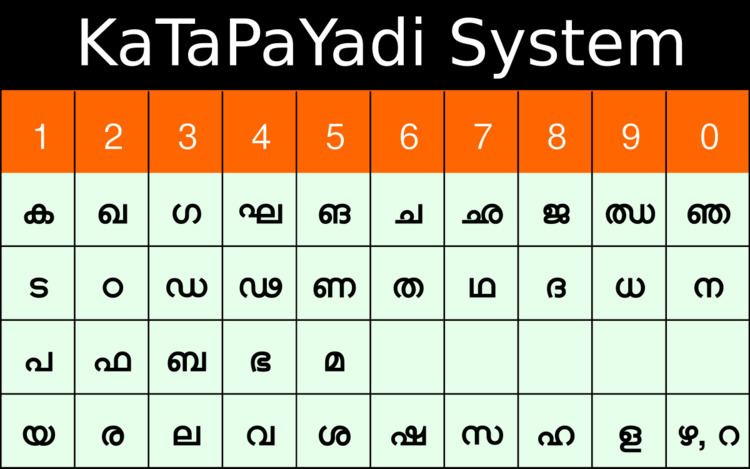 | ||
Ka·ṭa·pa·yā·di (Devanagari: कटपयादि) system (also known as Paralppēru, Malayalam: പരല്പ്പേര്) of numerical notation is an ancient Indian system to depict letters to numerals for easy remembrance of numbers as words or verses. Assigning more than one letter to one numeral and nullifying certain other letters as valueless, this system provides the flexibility in forming meaningful words out of numbers which can be easily remembered.
Contents
History
The oldest available evidence of the use of Kaṭapayādi (Sanskrit: कटपयादि) system is from Grahacāraṇibandhana by Haridatta in 683 CE. It has been used in Laghu·bhāskarīya·vivaraṇa written by Śaṅkara·nārāyaṇa in 869 CE.
Some argue that the system originated from Vararuci. In some astronomical texts popular in Kerala planetary positions were encoded in the Kaṭapayādi system. The first such work is considered to be the Chandra-vakyani of Vararuci, who is traditionally assigned to the fourth century CE. Therefore, sometime in the early first millennium is a reasonable estimate for the origin of the Kaṭapayādi system.
Aryabhata, in his treatise Ārya·bhaṭīya, is known to have used a similar, more complex system to represent astronomical numbers. There is no definitive evidence whether the Ka-ṭa-pa-yā-di system originated from Āryabhaṭa numeration.
Geographical spread of the use
Almost all evidences of the use of Ka-ṭa-pa-yā-di system is from south India, especially Kerala. Not much is known about its use in north India. However, on a Sanskrit astrolabe discovered in north India, the degrees of the altitude are marked in the Kaṭapayādi system. It is preserved in the Sarasvathy Bhavan Library of Sampurnanand Sanskrit University, Varanasi.
The Ka-ṭa-pa-yā-di system is not confined to India. Some Pali chronograms based on the Ka-ṭa-pa-yā-di system have been discovered in Burma.
Rules and practices
Following verse found in Śaṅkaravarman's Sadratnamāla explains the mechanism of the system.
नज्ञावचश्च शून्यानि संख्या: कटपयादय:।
मिश्रे तूपान्त्यहल् संख्या न च चिन्त्यो हलस्वर:॥
Transiliteration:
nanyāvacaśca śūnyāni saṃkhyāḥ kaṭapayādayaḥ
miśre tūpāntyahal saṃkhyā na ca cintyo halasvaraḥ
Translation: na (न), nya (ञ) and a (अ)-s, i.e., vowels represent zero. The nine integers are represented by consonant group beginning with ka, ṭa, pa, ya. In a conjunct consonant, the last of the consonants alone will count. A consonant without vowel is to be ignored.
Explanation: The assignment of letters to the numerals are as per the following arrangement.
Variations
Mathematics and astronomy
vyāsastadarddhaṃ tribhamaurvika syāt
It gives the circumference of a circle of diameter, anūnanūnnānananunnanityai (10,000,000,000) as caṇḍāṃśucandrādhamakuṃbhipālair (31415926536).This verse directly yields the decimal equivalent of pi divided by 10: pi/10 = 0.31415926535897932384626433832792
గోపీభాగ్యమధువ్రాత-శృంగిశోదధిసంధిగ | ఖలజీవితఖాతావ గలహాలారసంధర ||Carnatic music
- Melakartas 1 through 36 have Ma1 and those from 37 through 72 have Ma2.
- The other notes are derived by noting the (integral part of the) quotient and remainder when one less than the melakarta number is divided by 6.
- 'Ri' and 'Ga' positions: the raga will have:
- Ri1 and Ga1 if the quotient is 0
- Ri1 and Ga2 if the quotient is 1
- Ri1 and Ga3 if the quotient is 2
- Ri2 and Ga2 if the quotient is 3
- Ri2 and Ga3 if the quotient is 4
- Ri3 and Ga3 if the quotient is 5
- 'Da' and 'Ni' positions: the raga will have:
- Da1 and Ni1 if remainder is 0
- Da1 and Ni2 if remainder is 1
- Da1 and Ni3 if remainder is 2
- Da2 and Ni2 if remainder is 3
- Da2 and Ni3 if remainder is 4
- Da3 and Ni3 if remainder is 5
Raga Dheerasankarabharanam
The katapayadi scheme associates dha
Raga MechaKalyani
From the coding scheme Ma
Exception for Simhendramadhyamam
As per the above calculation, we should get Sa
Representation of dates
Important dates were remembered by converting them using Kaṭapayādi system. These dates are generally represented as number of days since the start of Kali Yuga. It is sometimes called kalidina sankhya.
